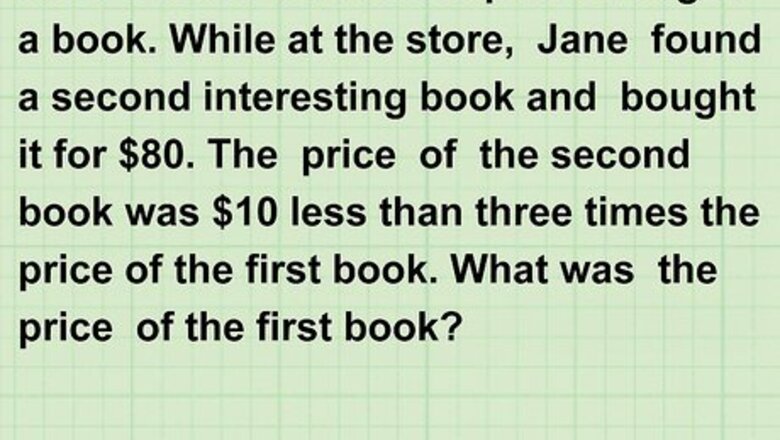
views
Assessing the Problem
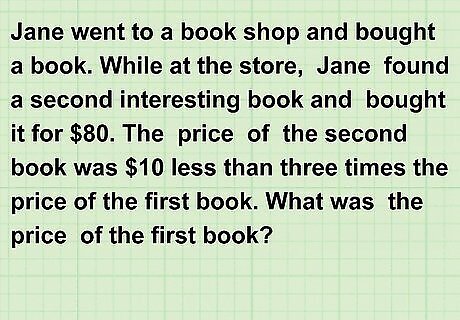
Read the problem carefully. A common setback when trying to solve algebra word problems is assuming what the question is asking before you read the entire problem. In order to be successful in solving a word problem, you need to read the whole problem in order to assess what information is provided, and what information is missing.
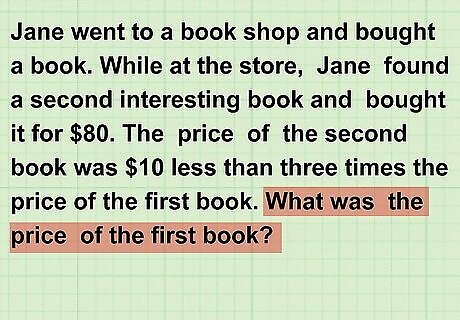
Determine what you are asked to find. In many problems, what you are asked to find is presented in the last sentence. This is not always true, however, so you need to read the entire problem carefully. Write down what you need to find, or else underline it in the problem, so that you do not forget what your final answer means. In an algebra word problem, you will likely be asked to find a certain value, or you may be asked to find an equation that represents a value. For example, you might have the following problem: Jane went to a book shop and bought a book. While at the store Jane found a second interesting book and bought it for $80. The price of the second book was $10 less than three times the price of he first book. What was the price of the first book? In this problem, you are asked to find the price of the first book Jane purchased.
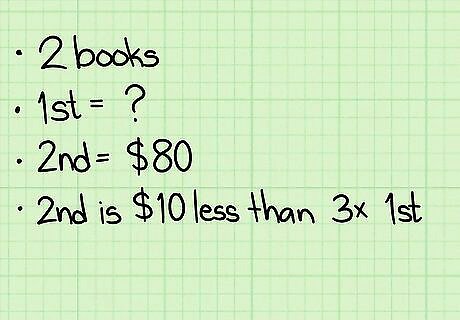
Summarize what you know, and what you need to know. Likely, the information you need to know is the same as what information you are asked to find. You also need to assess what information you already know. Again, underline or write out this information, so you can keep track of all the parts of the problem. For problems involving geometry, it is often helpful to draw a sketch at this point. For example, you know that Jane bought two books. You know that the second book was $80. You also know that the second book cost $10 less than 3 times the price of the first book. You don't know the price of the first book.

Assign variables to the unknown quantities. If you are being asked to find a certain value, you will likely only have one variable. If, however, you are asked to find an equation, you will likely have multiple variables. No matter how many variables you have, you should list each one, and indicate what they are equal to. For example, assign the variable x {\displaystyle x} x to the unknown in the problem, which is the price of the first book. Write x = the price of the first book {\displaystyle x={\text{the price of the first book}}} x={\text{the price of the first book}}.
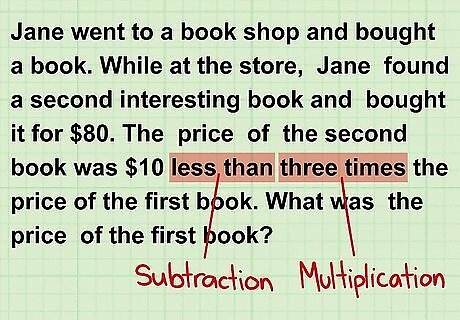
Look for keywords. Word problems are full of keywords that give you clues about what operations to use. Locating and interpreting these keywords can help you translate the words into algebra. Multiplication keywords include times, of, and factor. Division keywords include per, out of, and percent. Addition keywords include some, more, and together. Subtraction keywords include difference, fewer, and decreased.
Finding the Solution
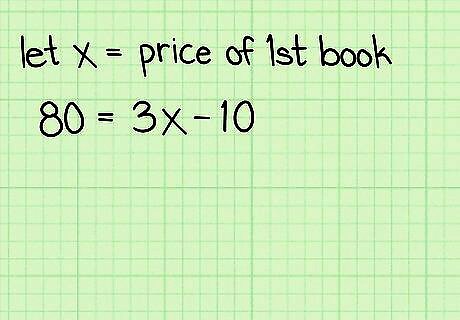
Write an equation. Use the information you learn from the problem, including keywords, to write an algebraic description of the story. For example, you know that the second book is $80, and you know what $80 equals in terms of the price of the first book ( x {\displaystyle x} x). So set 80 equal to $10 less ( − 10 {\displaystyle -10} -10 ) than 3 times the price of the first book ( 3 x {\displaystyle 3x} 3x). Putting everything together, you have 80 = 3 x − 10 {\displaystyle 80=3x-10} 80=3x-10.
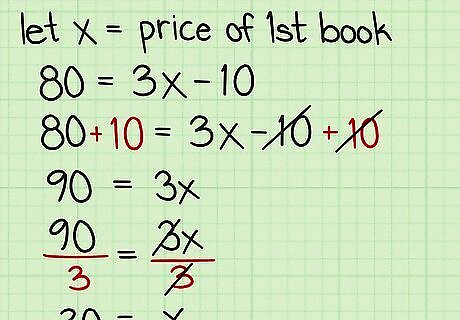
Solve an equation for one variable. If you have only one unknown in your word problem, isolate the variable in your equation and find which number it is equal to. Use the normal rules of algebra to isolate the variable. Remember that you need to keep the equation balanced. This means that whatever you do to one side of the equation, you must also do to the other side. Use inverse operations to isolate a variable. For example, to isolate the variable in the equation 80 = 3 x − 10 {\displaystyle 80=3x-10} 80=3x-10, you need to add 10 to both sides, then divide by 3: 80 = 3 x − 10 {\displaystyle 80=3x-10} 80=3x-10 80 + 10 = 3 x − 10 + 10 {\displaystyle 80+10=3x-10+10} 80+10=3x-10+10 90 = 3 x {\displaystyle 90=3x} 90=3x 90 3 = 3 x 3 {\displaystyle {\frac {90}{3}}={\frac {3x}{3}}} {\frac {90}{3}}={\frac {3x}{3}} 30 = x {\displaystyle 30=x} 30=x

Solve an equation with multiple variables. If you have more than one unknown in your word problem, you need to make sure you combine like terms to simplify your equation. When combining like terms, remember that only terms with the same exponent and variable can be combined. For example, 4 x {\displaystyle 4x} 4x and 2 x {\displaystyle 2x} 2x can be combined, 3 x 2 {\displaystyle 3x^{2}} 3x^{{2}} and 5 x 2 {\displaystyle 5x^{2}} 5x^{{2}} can be combined, and 8 x y {\displaystyle 8xy} 8xy and 4 x y {\displaystyle 4xy} 4xy can be combined.

Interpret your answer. Look back to your list of variables and unknown information. This will remind you what you were trying to solve. Write a statement indicating what your answer means. For example, since x = the price of the first book {\displaystyle x={\text{the price of the first book}}} x={\text{the price of the first book}}, and 30 = x {\displaystyle 30=x} 30=x, you know that the price of the first book Jane bought was $30.
Completing a Sample Problem
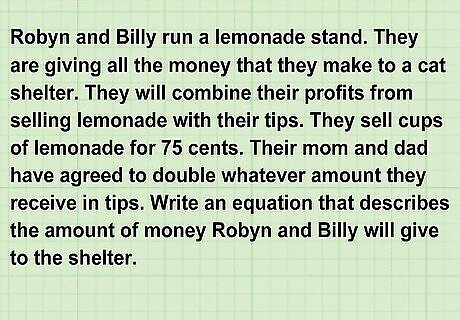
Solve the following problem. This problem has more than one unknown value, so its equation will have multiple variables. This means you cannot solve for a specific numerical value of a variable. Instead, you will solve to find an equation that describes a variable. Robyn and Billy run a lemonade stand. They are giving all the money that they make to a cat shelter. They will combine their profits from selling lemonade with their tips. They sell cups of lemonade for 75 cents. Their mom and dad have agreed to double whatever amount they receive in tips. Write an equation that describes the amount of money Robyn and Billy will give to the shelter.
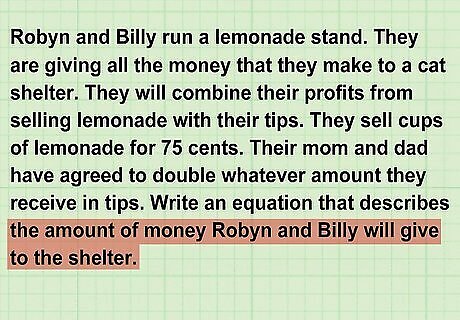
Read the problem carefully and determine what you are asked to find. You are asked to find how much money Robyn and Billy will give to the cat shelter.
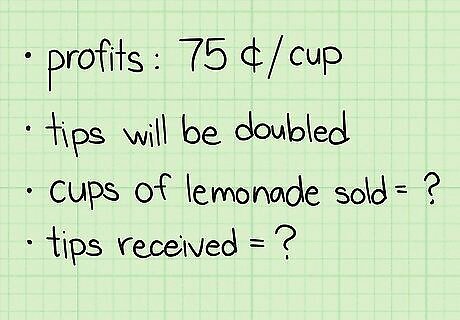
Summarize what you know, and what you need to know. You know that Robyn and Billy will make money from selling cups of lemonade and from getting tips. You know that they will sell each cup for 75 cents. You also know that their mom and dad will double the amount they make in tips. You don't know how many cups of lemonade they sell, or how much tip money they get.
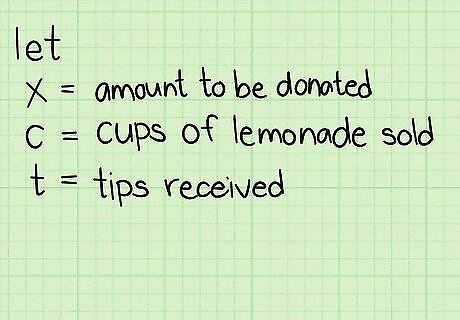
Assign variables to the unknown quantities. Since you have three unknowns, you will have three variables. Let x {\displaystyle x} x equal the amount of money they will give to the shelter. Let c {\displaystyle c} c equal the number of cups they sell. Let t {\displaystyle t} t equal the number of dollars they make in tips.
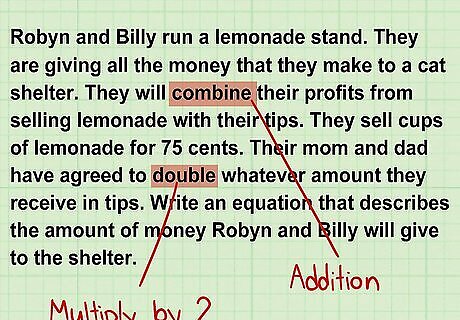
Look for keywords. Since they will “combine” their profits and tips, you know addition will be involved. Since their mom and dad will “double” their tips, you know you need to multiply their tips by a factor of 2.
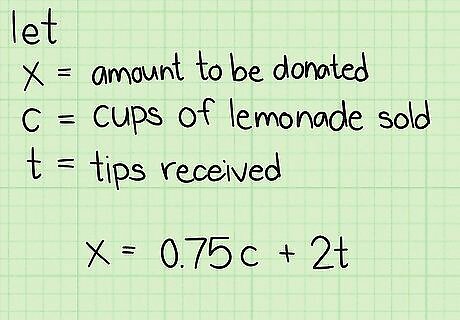
Write an equation. Since you are writing an equation that describes the amount of money they will give to the shelter, the variable x {\displaystyle x} x will be alone on one side of the equation. Since you are combining their profits and tips, you will be adding two terms. So, x = __ + __. The first term will be equal to their profits. Since they make $0.75 for every cup of lemonade they sell, their profits are equal to .75 c {\displaystyle .75c} .75c. So, x = .75 c + ? ? {\displaystyle x=.75c\;+\;??} x=.75c\;+\;??. The second term will be equal to their tips. Since their parents are doubling their tips, their tips will be equal to 2 t {\displaystyle 2t} 2t. So, x = .75 c + 2 t {\displaystyle x=.75c+2t} x=.75c+2t. Since the variable you are describing is already isolated, and all like terms are combined, you have arrived at your final answer.
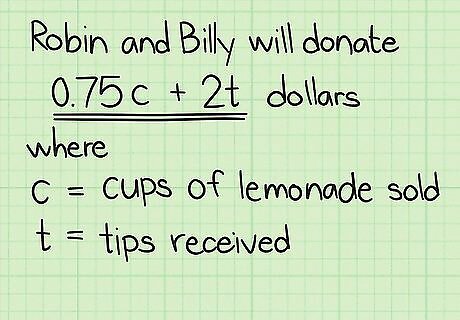
Interpret your answer. The variable x {\displaystyle x} x equals the amount of money Robyn and Billy will donate to the cat shelter. So, the amount they donate can be found by multiplying the number of cups of lemonade they sell by .75, and adding this product to the product of their tip money and 2.












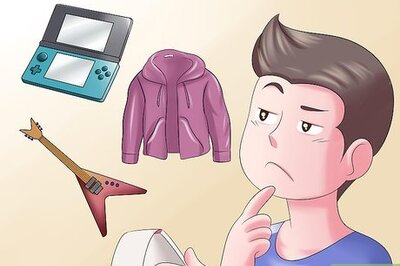



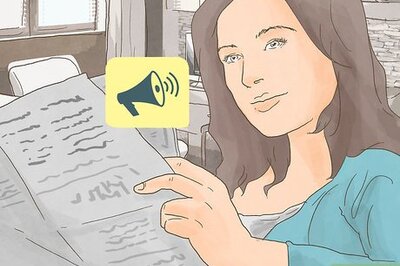



Comments
0 comment